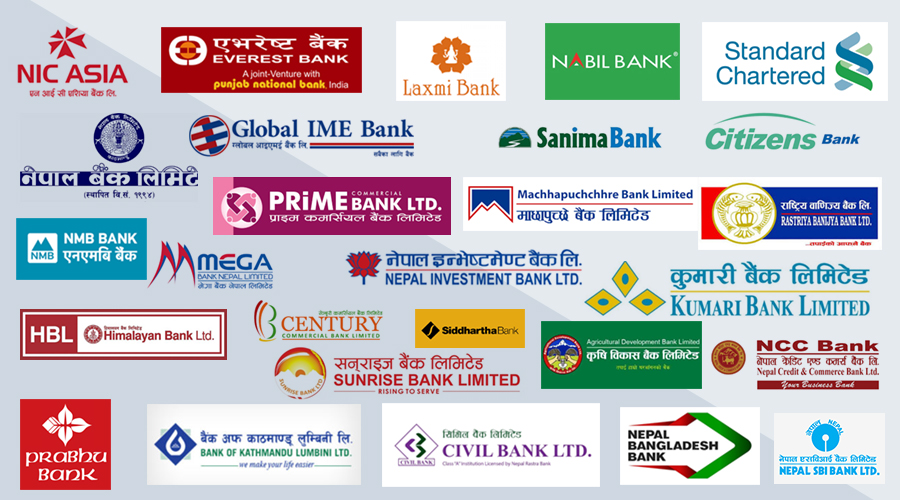KATHMANDU: Banks have suffered a steep decline in net profits in the last fiscal year 2019/20.
According to the fourth quarter results of 27 commercial banks for last fiscal year 2019/20, their net profit plummeted as the COVID-19 wreaked havoc on the economy.
Profits of Nepali banks fell by 13.79 percent to Rs 54.32 billion in the last fiscal year compared to the previous fiscal year as banks also started to feel the pinch of the coronavirus pandemic, the compiled financial results show. They had earned a combined profit of Rs 63 billion in the previous fiscal year 2018/19.
The figures are subject to the audit and regulatory review.
The banking sector, which has been reporting continued growth in profits for the past several years, failed to maintain the momentum in the last fiscal year as their profitability took a hit due to the pandemic.
But, the slump in their earnings in the last fiscal did not come as a surprise.
The outbreak of COVID-19 and subsequent containment measures imposed by the government were expected to cripple economic activities andput a dent in the banking sector’s business.
Not only did the pandemic impact banking operation but banks could not recover loans due to the four-month lockdown imposed in March. The last quarter (mid-April to mid-July)of the fiscal is considered to be a period when banks focus mostly on recovery. As borrowers could not service their loans due to the COVID-19 and the central bank’s deferral notice on loan repayment deadline, it hit the banks’ income.
Looking into some of the major indicators that define their performance would help understand how banksmade lower profit in the last fiscal 2019/20.
WAIVER ON LENDING RATES WEIGHS ON EARNINGS
It’s not that banks did not observe growth in their business. The business growth—as measured through deposit and loans—remained average. The combined deposits rose by 20 percent to Rs 3.49 trillion from Rs 2.91 trillion as compared to growth of 18.9 percent in the previous year. Similarly, loans and advances also went up 16.52 percent as compared to growth of 18.19 percent in the previous year.
However, the growth in business volume of banks did not translate into interest income—the major source of earnings for Nepali banks.
Their combined net interest income—the difference between what they earn from loans and what they pay to depositors—stood at Rs 128.75 billion in the last fiscal year 2019/20, a marginal growth of 1.5 percent. Such income was Rs 127.44 billion, up by a whopping 26.22 percent in the previous year.
So, what squeezed their profits?
The decision of Nepal Rastra Bank (NRB) to slash two percentage points on lending rate for borrowers impacted by COVID-19 weighed on interest income in the last quarter. The cut of two percentage points on lending rates for borrowers as required by the central bank in the fourth quarter as part of financial relief to businesses impacted by coronavirus hit the banks’ bottom line.
“Banks’ earnings were already under pressure due to growing competition in the market as well as the interest spread cap,” said Bhuvan Dahal, president of Nepal Bankers’ Association. “The decision to cut two percentage points sharply decelerated the net interest income of banks,” he added.
Bankers also say that the interest rate spread cap of 4.4 percent for banks has also been squeezing their profit margins. Under this rule, a bank’s difference on average deposit rate and lending rate should not exceed 4.4 percent. The interest rate spread cap introduced by NRB as a measure to ensure that banks do not profiteer at the expense of borrowers or depositors has long been criticized by bankers.
HUGE PROVISIONING ON SOURING LOANS
While the central bank’s decision to provide two-percentage-point waiver on lending rates led to a decline in their interest earnings, the coronavirus pandemic also soured a huge amount of bank loans. As banks’ cost for loan loss provisioning increased significantly, it deteriorated their profitability.
Banks set aside a total of Rs 18.7 billion to guard against future credit losses after the repayment was either delayed or the loans were defaulted. The loan loss provisioning jumped by a whopping 157 percent in the last fiscal year due to the adverse impact of coronavirus on businesses and economic activities. The huge increase on cost for writing-off bad loans as known as impairment charges took a toll on their profit.
However, the impact of the coronavirus has been cushioned somewhat by policy responses from NRB.
The impairment charges would have been far higher for banks if the central bank had not introduced a relaxation on classifying of loans and requirement for the provisioning. The central bank had allowed banks to not classify some of the loans extended to businesses hit by COVID-19 as bad loans and provision losses even if their repayment has been deferred.
“If it was not for the relaxation offered by the central bank on classification of loans and provisioning requirements, the situation for the banking industry would have been worse. Some banks would have been in the red,” said a banker seeking anonymity, referring to the possibility of banks registering net losses.
POSSIBILITY OF BOUNCE BACK?
The challenge to maintain profitability is expected to extend for banks in the current fiscal year as the situation is less likely to improve. It was only the fourth quarter that was impacted by the coronavirus pandemic in the last fiscal year that gave bankers a hard time. Amid the uncertainty of the coronavirus pandemic that still looms on the economy, bankers say that they have to be prepared for the worst. “If the pandemic during a single quarter could have such a big impact, we have to be prepared for massive losses as the coronavirus outbreak is getting worse,” said a banker.

